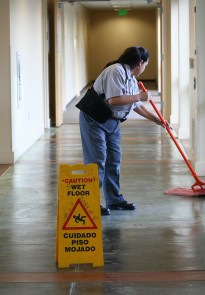Abortion rights, women of color, and LGBTQI+ people are under attack. Pledge to join us in fighting for gender justice.
Much of March Job Growth Is Low-Wage
Many news headlines are hailing the 215,00 job gains in today’s Bureau of Labor Statistics’ release as a sign of a continuing economic recovery. While the topline figure is good news, a closer look reveals that for both men and women job growth this month was disproportionately in the low-wage sectors of retail and leisure & hospitality.
Here’s the scoop:
- Two-thirds of the 215,000 jobs added in March went to women.
- Women’s biggest job gains were in the low-wage sectors of retail (+25,300) and leisure & hospitality (+23,000), as well as the private education & health services sector (+44,000). Low-wage jobs accounted for 34 percent of all job growth for women this month.
- Men also saw big job gains in low-wage sectors: retail (+22,400), leisure & hospitality (+17,000), as well as construction (+34,000). Low-wage job gains made up 55 percent of men’s jobs this month.

While low-wage jobs saw particularly large gains in March, they’ve accounted for a disproportionate share of job growth over the last year. This growth is troubling, because we have ample evidence of how the untenable conditions of these jobs wreak havoc on the lives of workers and their families. Low-wage work often leaves women working full time below or near the poverty line and unable to balance work and caregiving responsibilities. It looks like New York and California are about to enact legislation that will raise their minimum wages to $15/hour; however, the economic security of women in low-wage jobs shouldn’t depend on their zip code.
Turning to this month’s unemployment data, we saw an increase in unemployment for many vulnerable groups of women and men.
- Among adult African Americans (20 and older), the unemployment rate ticked up from 7.9 percent to 8.0 percent for women and from 8.6 percent to 8.7 percent for men.
- The unemployment rate for Latinas (20 and older) also edged up, from 5.4 percent to 5.5 percent, and for Latinos (20 and older) from 4.7 percent to 4.8 percent.
- For single mothers, unemployment dropped from 7 percent to 6.8 percent. This rate is still 2.2 percentage points greater than for adult women overall.
- Women and men ages 16-64 with disabilities continued to face alarmingly high double-digit rates of unemployment, 10.7 percent for women and 12.8 percent for men.
In addition to raising the minimum wage, there are currently policy decisions being made that would greatly benefit, or greatly harm, these vulnerable groups. While the Fiscal Year 2017 budgets proposed by President Obama and by the Congressional Progressive Caucus would make critical investments to support women and their families, the budget proposed by House Budget Chairman Tom Price would do just the opposite, by cutting services that millions of women and their families depend on. Let’s keep reminding policymakers of these numbers as Congress continues to weigh our nation’s spending priorities in the coming months.





